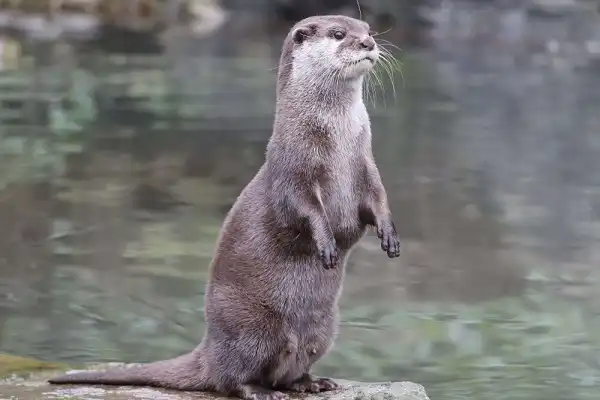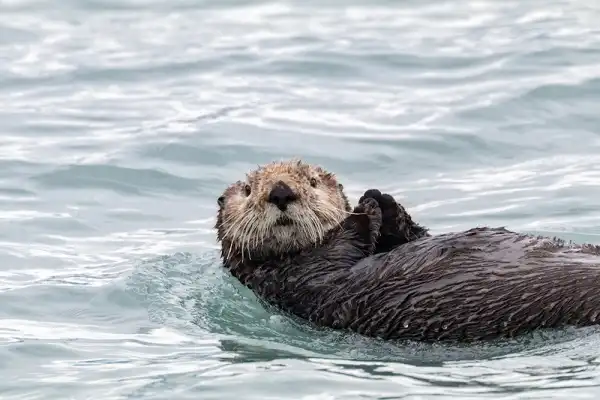Did you know that otters are one of the most playful animals in the world? They often frolic and play in the water, and on land, they can be seen sliding down hills or wrestling with each other. Otters are very social creatures, living in family groups called “rafts.” In this article, we’ll explore some interesting facts about these amazing animals.

Otter Description
Otters are adorable, playful animals. Otters are social creatures and can often be found cuddling together for warmth during cold nights. They have retractable claws which make them excellent swimmers as well as adept hunters of fish and crustaceans. These fascinating mammals come in different shapes, sizes, colors, and species. They have a thick fur coat that helps protect them from cold water temperatures as well as predators.
Otter Habitat
Otters live in a variety of habitats, from freshwater rivers and lakes to oceans and seas. They are found on every continent except Antarctica and can adapt to different temperatures and environments. Otters are semi-aquatic creatures, meaning they spend time both on land and in the water. On land, they often sleep in dens near the edge of a body of water or burrow into the banks. In the water, otters use a variety of techniques to find food such as diving for shellfish and chasing fish. Otters play an important role in maintaining the health of their habitats by providing food for larger animals such as sharks, dolphins, seals, sea lions, whales, and even some birds. They also improve water quality by consuming large amounts of algae-eating invertebrates such as snails which helps prevent eutrophication or overgrowth of algae that can lead to oxygen depletion in aquatic environments.
Otter Diet
Otters have a varied diet that consists of both plants and animals. They feed on fish, crustaceans, mollusks, aquatic invertebrates, amphibians, small birds and mammals, eggs, sea urchins, clams, and other bivalves. On land, they may eat insects, earthworms, carrion, and fruits. The diet of an otter can vary greatly depending on its size as well as where it lives. For example, in areas with plentiful food sources such as estuaries or coastal areas, their diets consist of mostly fish and crustaceans while in areas with fewer resources, they may consume amphibians or small mammals.
In a general adult, otters will consume around 2-4 pounds of food per day which is about 15-25% of their own body weight. Sea otters particularly have a voracious appetite and can eat up to 30% of their body weight daily! To satisfy this hunger they spend much of their time foraging along the shoreline or diving into deeper waters hunting for prey. In addition to their carnivorous diet otters also enjoy some plant materials such as roots, bulbs, and tubers which provide them with important minerals like calcium and phosphorus. They use tools such as stones to crack open the shells of their prey so they can feed on the contents inside.

Otter Size
Otters come in a variety of sizes and shapes, depending on the species. The smallest otter is the Asian small-clawed otter which grows to an average length of 16-21 inches and can weigh up to 11 lbs. On the other end of the size range are sea otters, which can measure up to 4 feet long and weigh up to 85 pounds! The most common type of otter found around the world is the European or Eurasian river otter which typically grows to be between 2 – 3 ft long and can weigh anywhere from 6 – 18 lbs. Otters also possess a set of webbed feet that help them propel through the water with incredible speed and agility. This adaptation allows them to swim up to 6 mph while diving down to depths of 30 meters in search of food!
Otter Lifespan
The average lifespan of an otter can vary greatly depending on the species, as well as its environment and access to food resources. Generally speaking, most species of otters tend to live for roughly 8-10 years in the wild, although some individuals have been known to reach up to 20 years in captivity. In comparison, sea otters tend to have a much longer life expectancy with some individuals reaching up to 25-30 years! The habitat of an otter also plays a crucial role in its lifespan. Otters that live in areas with ample food sources may be able to survive longer due to better nutrition and more opportunities for activity. On the other hand, those that are exposed to environmental pressures such as pollution or overfishing may find it difficult to sustain their populations as they will not have enough prey available. Finally, age-related issues such as arthritis or blindness can also contribute to earlier death for some older otters. Overall it is safe to say that these animals are particularly long-lived given the right circumstances!
Otter Behavior
Otters are incredibly active animals that can be seen engaging in various behaviors both in the water and on land. In the wild, otters are often seen playing with one another or interacting with objects in their environment. This type of social behavior is important for them to bond and form close relationships with each other. Studies have also shown that some species of otters even practice cooperative hunting, where they work together to capture prey by herding it into shallow areas where it can be easily consumed. On land, otters can often be seen wrestling and playing around with each other. This playful behavior serves as a way for them to build trust and learn how to interact with their peers. It also serves as a form of exercise, helping the animals stay fit and agile while sharpening their reflexes. As they wrestle, they will often groom each other’s fur which helps maintain its waterproofing qualities.
In addition, to play fighting and grooming, otters also use vocalizations such as whistles or chirps to communicate with one another. These sounds are used for a variety of different purposes including mating calls, territorial displays, and warning signals when there is danger nearby. Other forms of communication include scent marking (using urine or anal gland secretions), posturing (such as arching the back), or physical contact like nose-to-nose touching or caressing one another with their paws. Overall these fascinating creatures display many interesting behaviors that have likely been shaped by hundreds of years of evolution!

Otter Speed
Otter speed is one of the most impressive features of these aquatic mammals. These animals are well adapted to their marine environment and can use their tail and webbed feet in combination to propel themselves through the water at remarkable speeds. Different species of otters have different swimming capabilities, but some have been clocked traveling at speeds up to 35 km/h (21 mph). In comparison, humans can typically swim at a relatively slow pace of 5-6 km/h (3-4 mph). The fastest species of otter is the giant otter, which uses its long tail for propulsion and can reach peak speeds of up to 25 km/h (15 mph).
Sea otters are also quite fast, able to swim around 19 km/h (12 mph) on average. This is particularly impressive given that their hind limbs are not as well developed as those in other species and they rely mainly on their front limbs for locomotion. Apart from swimming, otters are also capable runners on land and some species can reach speeds up to 16 km/h (10 mph). The European Otter is particularly known for being fast on both land and sea, using its strong legs to generate a burst of speed when running or swimming away from predators.
Otter Hunting
Otter hunting is an activity that these aquatic mammals have been engaging in for hundreds of years. Otters are incredibly adept hunters, with a wide range of adapted skills and behaviors which they use to track down and capture prey. The most common hunting technique used by otters is known as ‘still-hunting’. This involves the animal stalking its target through the water or on land before making a sudden dash to catch them. Otters will often use their tails to help propel themselves forward during this burst of speed, enabling them to quickly close the gap between them and their intended prey. Once within striking distance, the otter will reach out with its paw to grab hold of the victim and drag it back into the water where it can be consumed.
In addition to still-hunting, some species of river otter may employ a tactic known as ‘worm-floating’. This involves an otter submerging itself in water and then floating motionlessly on its back while waiting for small fish, crabs, or other food sources to emerge near the surface. The animal will then quickly flip over and snatch up whatever comes nearby before flipping back onto its back again to resume floating. Some species of otter also utilize tools when hunting; sea otters are especially known for using rocks or sticks to crack open clams or shellfish which they find underwater.

Conclusion
Otters are undeniably one of the most adaptable and versatile animals on the planet. They possess a wide range of skills and behaviors that enable them to thrive in both aquatic and terrestrial habitats. From reaching impressive speeds through swimming or running to utilizing tools when hunting—otters demonstrate remarkable intelligence and strength that has enabled them to survive for hundreds of years. They truly are an amazing species!
Frequently Asked Question

